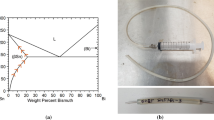Abstract
Tin-bismuth alloys may be an alternative to lead-based solders for low-temperature applications, but very little is known about their manufacturability and reliability. This article presents an overview of these issues. First, experiments to determine the wetting properties of the Sn-Bi solder are presented. The results show that Sn-Bi solders do not wet bare copper well, but that they do wet copper having a hot-dipped Sn-Bi coating. Next, the effects of aging on the microstructure of Sn-Bi solders are described. The results show that during aging, tin is de-pleted from the solder/base metal interface. The two-phase Sn-Bi microstructure coarsens during aging; the rate of coarsening can be slowed by adding 1.0 wt. % Cu to the solder. The aging also affects the shear strength of the solder joints, where aged joints show an increase in maximum shear stress and ductility at failure.
Similar content being viewed by others
References
Lists of commercially available solders, for example Indalloy Specialty Solders and Alloys (Utica, NY: The Indium Corporation of America).
R.N. Wild, “Properties of Some Low Melt Fusible Solder Alloys” (Paper presented at INTER/NEPCON, Brighton, U.K., 19–21 October 1971).
W.J. Tomlinson and I. Collier, “The Mechanical Properties and Microstructures of Copper and Brass Joints Soldered with Eutectic Tin-Bismuth Solder,” J. Mater. Sci., 22 (1987), pp. 1835–1839.
S. Pattanaik and V. Raman, “Deformation and Fracture of Bismuth-Tin Eutectic Solder,” Materials Developments in Microelectronic Packaging, ed. P.J. Singh (Materials Park, OH: ASM, 1991), pp. 251–257.
Z. Gou et al., “Monotonic Properties and Low-Cycle Fatigue of Several Soft Solder Alloy Systems,” in Ref. 4, pp. 155–162.
J.S. Hwang and R.M. Vargas, “Solder Joint Reliability—Can Solder Creep?” Soldering and Surface Mount Technology (June 1990), p. 38.
D.R. Frear, “Thermomechanical Fatigue in Solder Materials,” Solder Mechanics: A State of the Art Assessment, ed. D.R. Frear, W.B. Jones, and K.R. Kinsman (Warrendale, P A: TMS, 1991), pp. 191–237.
W.J. Tomlinson and G.A. Cooper, “Fracture Mechanisms of Brass/Sn-Pb-Sb Solder Joints and the Effect of Production Variables on Joint Strength,” J. Mater. Sci., 21 (1986), pp. 1730–1734.
W.J. Tomlinson and N.J. Bryan, “The Strength of Brass/Sn-Pb-Sb Solder Joints Containing 0 to 10% Sb,” J. Mater. Sci., 21 (1986), pp. 103–109.
L. Quan et al., “Tensile Behavior of Pb-Sn Solder/Cu Joints,” J. Electronic Mater., 16 (1987), pp. 203–208.
L.E. Felton et al., “The Morphology of Cu-Sn Intermetallics in Cu/Pb-Sn Solder Joints,” in Ref. 4, pp. 23–27.
C.A. MacKay and W.D. von Voss, “Effect of Compositional Changes and Impurities on Wetting Properties of Eutectic Sn-Bi Alloy Used as a Solder,” Mat. Sci. Tech., 1 (1985), pp. 240–248.
Author information
Authors and Affiliations
Rights and permissions
About this article
Cite this article
Felton, L.E., Raeder, C.H. & Knorr, D.B. The properties of tin-bismuth alloy solders. JOM 45, 28–32 (1993). https://doi.org/10.1007/BF03222377
Issue Date:
DOI: https://doi.org/10.1007/BF03222377




